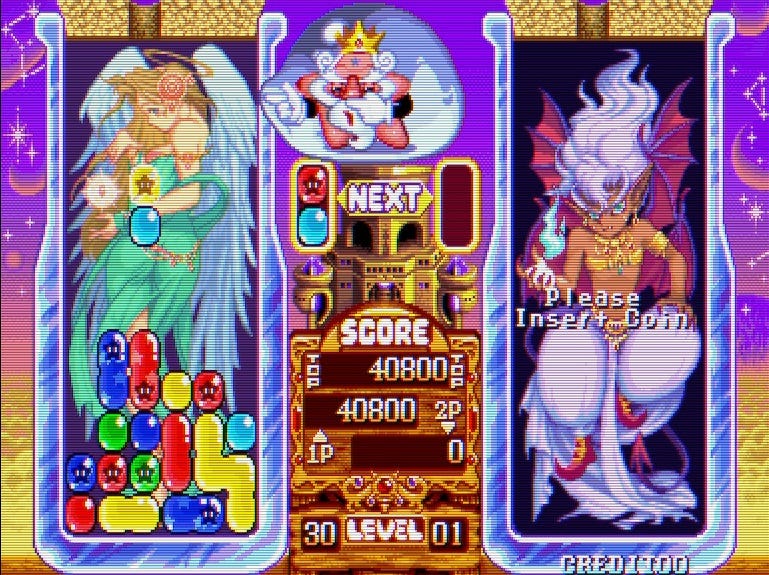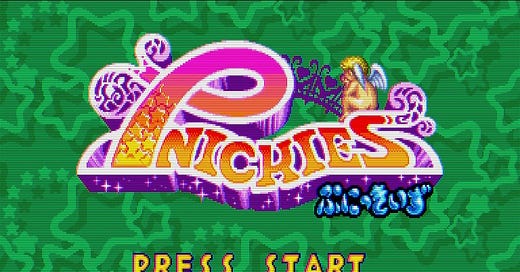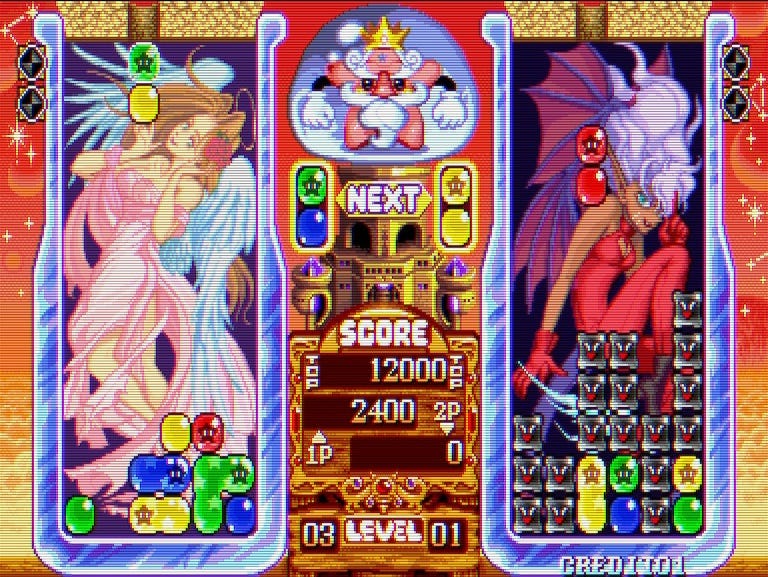XP Arcade: Pnickies
A Capcom game that's actually a Compile game that set the table for a different Capcom game you actually know of.
This column is “XP Arcade,” in which I’ll focus on a game from the arcades, or one that is clearly inspired by arcade titles, and so on. Previous entries in this series can be found through this link.
If it looks like a Compile game, sounds like a Compile game, shares some very clear gameplay connections with a Compile game, but isn’t technically a Compile game, then what is it? A Capcom game, in the instance of falling block puzzle arcade game Pnickies, though, that’s not completely true, either. Compile was involved in Pnickies: the problem here is that it’s unclear how involved, at least as far as an official accounting of things goes.
Look no further than the title screen of Pnickies for proof. The game was licensed to Capcom by Compile in its release year of 1994. Capcom has the credits for publishing and developing Pnickies basically wherever you look, however, and Pnickies isn’t included in the list of games that Compile developed at Wikipedia (though, it is included at LaunchBox). That’s not exactly a unique situation, though, at least as far as that list goes: individual games within Compile’s Disk Station releases, which were for subscribers to a “magazine” full of games made by Compile, aren’t listed at Wikipedia (or LaunchBox), either, and there were other times where Compile developed a game and wasn’t listed within the game itself as a developer, such as with their Crush series of pinball titles, where “Naxat Pinball” got the credit for something Compile essentially ghost developed. Proper crediting for what games Compile themselves developed is a project that didn’t get going in earnest until after they had already closed down, so one slipping through a couple of cracks isn’t a shock even at this late stage.
If you’ve ever played another Compile title outside of their shoot ‘em ups, Pnickies is very clearly their doing. The art and exaggerated animation is reminiscent of what you’d find in their Puyo Puyo series of falling block puzzle games, and between the pieces being gelatinous and capable of slipping right off one another to fall down separate columns after placement, it can play a bit like Puyo Puyo, as well. There’s just a couple of in-game songs — one for single player, one for competitive multiplayer — but they sound like they could have come from a Compile composer, and the sound effects say the same. So, the educated guess to make is that Compile either did develop this game despite the lack of credit, or, they pulled a Falcom with Ys IV and sketched out a game with some visual and audio assets, and then licensed it to Capcom for the actual production of the thing. The latter seems the most likely, since why, otherwise, would Compile get a licensing credit for their work, but not a development one? If you can see a ghost developer staring back at you, then why are they a ghost developer in the first place?
Capcom does own Pnickies at this point, that much is clear: it isn’t one of Compile’s many titles that ended up in the hands of D4 Enterprises post-bankruptcy, and we know that because D4’s name isn’t anywhere on the sales page for the title. Unlike Sega’s, which for some reason is. And no one who knows why has spoken up on the matter, either: it took the release of Pnickies on Capcom Arcade 2nd Stadium for the Sega part to even become known, and as Sega Retro pointed out, even Yosuke Okunari, who maintains Sega’s back catalogue, isn’t aware of what the connection is. Maybe, as part of Compile’s sale of Puyo Puyo to Sega, whatever their tiny share of Pnickies — or, at least, its concept — went with it? After all, that sale was supposed to be temporary, with Compile eventually buying it back from Sega. I’m not convinced of that hypothetical, though, since Sega wouldn’t have very much use for it if Capcom had already produced something with said concept, but there it is.
This is all fascinating, but what makes things even weirder is that it feels like Capcom didn’t end up adding anything beyond whatever Compile had provided. Pnickies is certainly finished, in the sense that you can put a quarter in a machine and then play it start to finish no problem, but it feels like it’s lacking something. It’s fun, for sure, but it’s missing that extra edge that Compile’s puzzle games tended to have, the kind that made Puyo Puyo so popular alone or with a friend, or Guri Logi Champ beloved by anyone who’s played it, and later efforts by its puzzle-loving ex-developers in series like Pochi and Nyaa so enjoyable. Which further adds to the idea that Compile didn’t make this entire game, but instead were contracted by Capcom to at least come up with something they could put together later themselves after being pointed in the right direction.
Again, the best guess is that Capcom didn’t build on whatever concepts and assets had been licensed to them by Compile like Alfa System and Hudson Soft did with, to go back to that well once more, Ys IV: The Dawn of Ys. Compile maybe just developing something quickly for Capcom without their usual level of polish could make sense as an explanation here, especially given how much of their staff had been lost or turned over in the few years prior. But that explanation seems less likely due to the lack of credit and the licensing being their only public association with the title. We’re doomed to go in circles here, so let’s talk how Pnickies plays, instead.
Pnickies is played on a narrow field, six blocks wide. The pieces come down in pairs of two, sometimes the same color, more often different, and you can see which piece is coming next in the shared space in the middle of the screen. Most of the game’s pieces are one of a few colors with white stars that you might not even notice, depending on how far away from your television you are (or how big it is or is not), but others will have a more noticeable star with eyes in the center of it. Those pieces are the key to clearing others from your play area.
Any grouping that includes two star pieces of the same color will clear. Two stars next to each other and nothing else? Cleared. Two stars six rows apart, but both contained within the same continual collection of a single color that stretches across those six rows? Convoluted, and also cleared. You score more points the more pieces are cleared at a time, so don’t always go for the easy clear. Like with Puyo Puyo, you want to go complicated here, and you can setup some complicated chains if you put some thought into it, and don’t gum up the works with too many of the wrong pieces in the wrong places. That’s good for point scoring, though, less for directly impacting gameplay itself such as in Puyo Puyo.

Also unlike Puyo Puyo, speed will end up playing a factor. Puyo Puyo is a slower affair where you’re very purposefully setting up future combos, and it’s your own skill that makes the game faster or slower, with the idea being the quicker you can clear pieces, the more garbage you can fill your opponent’s side up with — Google “Puyo Puyo speed up” if you want to be entertained by longtime Tetris players losing their minds on forums after experiencing the much slower game in Puyo Puyo Tetris. Puyo Puyo is not meant to be an endurance test, even in single-player mode, which is also player vs. player, albeit with one player being the computer. In Pnickies, speed will end up haunting you: the game will speed up and it will slow back down a la Columns, and when pieces start falling faster than you can both figure out where to place them and actually do said placing, you’re going to be in trouble. The goal here, rather than to win a series of matches in single-player is to clear 100 “levels,” with you starting on level one and working your way up by clearing and scoring.
And as said, it’s fun, but there’s not quite enough going on here to hook everyone on that 100-level idea. (My top level reached is nowhere near the end, and I’m knocking on the door of the top 200 in Capcom Arcade 2nd Stadium’s online leaderboards for Pnickies, anyway, which should give you an idea of how popular it isn’t within this collection.) However, Pnickies does work better, and has that bit of extra edge to it, in its competitive multiplayer mode — clears and combos build up a supply of garbage blocks to be dropped into your opponent’s play area, and which can only be cleared by another clear occurring directly next to them. Since you need time to build up combos for later, and speeding up combined with later, new colored pieces being added to the mix the deeper you get into things, this competitive play can be intense. None of which is a surprise, since that’s the direction the industry had already been going in by 1994.
At first, falling block puzzle games were enough as single-player affairs where you took turns trying to best your buddies’ scores, in situations reminiscent of Pnickies’ own single-player affair. That changed as the genre did, though. Compile’s Puyo Puyo had competitive multiplayer in 1991, but Columns II: Voyage Through Time had added that mode a year before. With the success of those two series, it felt late for Toaplan to avoid this kind of multiplayer in 1991 with Teki-Paki, and that’s at least one reason why the game didn’t catch on like it should have given its apparent quality otherwise. Tetris Battle Gaiden let the king of the genre join the competitive multiplayer party in 1993: even the Tetris name wasn’t enough to avoid going in this direction at that point in time. Pnickies had this kind of competitive multiplayer, as well, with garbage pieces dropped in your opponent’s play area aplenty. And it’s Pnickies’ competitive multiplayer, in conjunction with the game’s overall gameplay, that laid the foundation for Capcom’s Super Puzzle Fighter II Turbo.
Super Puzzle Fighter II Turbo switches from jellies to gems, but they act similarly, with a “loose” second piece falling from the placed piece if it’s hanging over an empty space. Pieces do not need to be cleared by being on the same line or column, but instead, they just need to be touching, like in Pnickies. They can only be cleared if a specific piece of the same color is touching them — the change from Pnickies there is you’ve gone from two to just one, which means you need to be even more careful if you’re building up for chains. The one major change, though, is that you can build up shapes with the pieces that will end up facilitating chains and significant point scoring, such as a 4x4 square with four of the same color block becoming a singular piece of the same piece, a large square that will later clear when another clear is earned with the same color blocks elsewhere. Whereas chains and combos are a nice to have in Pnickies, they’re all but required to make it through Super Puzzle Fighter II Turbo.
There’s another major change, though, less gameplay-centric. Super Puzzle Fighter II Turbo pulls from Capcom’s fighting game franchises for its characters, and they are more than just an avatar for you. Chun-Li, from the Street Fighter series, is the one who can build up that 4x4 square, for instance: that’s her specialty. Other fighters have different structures you can build that will result in some additional chains and point scoring opportunities. This gives the game an extra layer of strategy and reason to explore deeper into the game that Pnickies was lacking, and some personalization, too, since you can go for the character whose structure best reflects what your own mind is capable of putting together on the fly. Simplicity isn’t a bad thing on its own, and Pnickies is a good example of that. Super Puzzle Fighter II Turbo complicated things in the right ways, however, and is the more impressive and enjoyable title for it.
Pnickies, until its release on Capcom Arcade 2nd Stadium, had never left Japan nor the arcade. Super Puzzle Fighter II Turbo, however, received a worldwide arcade release, then was ported to the Playstation, Sega Saturn, Windows, Dreamcast, the Game Boy Advance, to mobile phones, and then received an HD update for the Playstation 3 and Xbox 360. It, too, is included in Capcom Arcade 2nd Stadium, which makes seeing the connective tissue between it and Pnickies that much easier.
If what happened with Pnickies is that Compile drew up design documents, assets, and so on, and Capcom made the simplest version of the game that was sketched out, well, this strategy might have harmed Pnickies a bit, but it ended up resulting in a killer puzzle title in Super Puzzle Fighter II Turbo, at least. And if is possible but maybe less likely occurred, and Compile did ghost develop Pnickies in its entirety and ended up with what, in hindsight, looks like the start of a great idea? That’s a shame, in the sense that Compile certainly could have used the win after the shooting game boom died down in arcades in favor of the fighters Capcom was producing. In the end, though, regardless of which it is, we ended up with both the simple but enjoyable Pnickies, and then superior Super Puzzle Fighter II Turbo. That’s not so bad, as far as possible outcomes go.
This newsletter is free for anyone to read, but if you’d like to support my ability to continue writing, you can become a Patreon supporter, or donate to my Ko-fi to fund future game coverage at Retro XP.






I'm a sucker for these games, but not that good at them...
I'm having memories of a similar game, where the characters were all based on tarot cards, I think? And maybe had different .. uh .. specials, that came with combos? It was a two-player speed battle left right split screen, but even against the AI was quite fun. Any idea what I'm talking about and if it's related to this or the same developer?